"The whole ceremony was very *you*" Part 5: Fraternité, Sororité, Sportivité
Does "frater", meaning "brother" in Latin, include women? The Paris 2024 Opening Ceremony creative team provided a very clear answer to this question. And I have a confession to make.
After the glorious “up yours” to French conservatives that was Égalité, it was time to unite everyone with the third pillar of the French motto: Fraternité, i.e. fraternity or brotherhood.
Fraternité
The Torchbearer walking through the Louvre reenacted the real-life Olympic Torch relay from a few days earlier. The image of iconic dancer and choreographer Marie-Claude Pietragalla dancing in front of priceless paintings while holding a live flame triggered some online outrage, but all security measures had been taken.
I saw the special firefighter crew who were following the flame through the Louvre, and the ceilings were high enough to accommodate a flame. You may have noticed that in smaller museums, the flame was in its protective lantern, so let’s move on. Some Louvre statues of pagan goddesses came alive to witness the Torchbearer’s passage, next to the goddess Niké (aka the winged victory of Samothrace, that will be featured again during the closing ceremony).
I personally liked that he jumped from the balcony of the Salle des Caryatides, as these four women sculpted by Jean Goujon connect two of my favourite things. Jean Goujon was the first sculptor of the Fontaine des Innocents, now located where many of the very first bones of the Catacombs came from (more on this here). It was - you guessed it - recently renovated, and there is a special exhibit about this fountain at Musée Carnavalet. These Louvre caryatids are also a major inspiration for the design of a better known Parisian fountain: the Wallace fountains! My audio tour takes you to one of the oldest ones, next to the prettiest reservoir in Paris, and provides more context. I also like that one of the first paintings that is shown empty of its characters is the Louvre copy of La mort de Marat (Marat’s death; the original is in Brussels).
Marat is one of the most famous French revolutionaries. He was assassinated in his bathtub by Charlotte Corday for being too hardcore, a reminder to everyone that not only nepo baby queens got killed during the French revolution.
The Torchbearer finds the paintings’ subjects all gathered at the museum windows to watch the athletes parading on the Seine river. Having been kettled by armed officers right under these windows as the ceremony started (see Part 1), I can confirm that these upper floors must have been great vantage points. But we couldn’t see anything from street level.
A confession
The idea of centuries’ worth of paintings visited by millions of people every year, suddenly leaving their frames “to watch the athletes, who are the true stars of the show” must have pleased the IOC. Sure, by being on the river, the athletes were technically center stage. But when you consider the ceremony as a whole, it was a bit of a bait-and-switch by the creative team: most of the impressive stuff happened on the banks and bridges, not on the athletes’ boats. Like hundreds of thousands of Parisians, I find watching people waving from bateaux-mouches rather boring, because it happens year-round in Paris. Also like hundred of thousands of Parisians, the fact they’re athletes doesn’t actually make a difference, because I just don’t find organized sport interesting in and of itself. Parisians who regretted having left the city after they saw the opening ceremony on TV didn’t regret spending more than 100 euros to be rained upon while waving at boats. They regretted missing the sheer magnitude of the artistic performances. Which you could only actually see properly on TV, i.e. you didn’t need to be in Paris.
I respect many types of human achievement, but I’m more impressed by revolutionaries who overthrow tyrants, by artists who convey the human condition in truly novel ways, and by scientists who create vaccines and prosthetic limbs, than by people who jump really far or shoot really well. Nurses save lives every day, and they get neither medals nor corporate endorsement deals. From decades of doping to corruption scandals, to being friendly to dictators and genocidal governments (the Uyghur genocide is still ongoing), to the environmental disaster of flying thousands of people from all around the world just to watch others exercise (international fans were the #1 source of carbon in Paris 2024), there are a lot of intrinsic ethical issues with the Olympic Games. To add insult to injury, they’re built on so many lies: Pierre de Coubertin was not the inclusive equalitarian he’s presented as, even for his time. The Olympic Torch relay is not an eternal tradition but a 1936 Nazi idea: from Italian fascists to the USA’s white supremacists to the logo of France’s Rassemblement National, the Far Right sure love their torches. Even the “Olympic Truce” is a lie: not only has it never materialized in the modern day games, but even in Ancient Greece, wars would not stop during the games. Athletes would be let through just like any other pilgrim, because competing in the games was a form of pilgrimage, but wars would carry on. Irrespective of what fans may think the “Olympic spirit” is, price gouging game tickets is part and parcel of what the Olympic Games stand for: the IOC is a money-making venture that pays lavish salaries to its managers, while using taxpayer money to pay for infrastructure and security. This is not some sort of not-for-profit organization where nobody gets paid, and where most people attend as a thank you for their community service or via free lotteries. Unlike the volunteers who make the games happen, Olympic bosses do get paid. A lot.
Another lie is that the Paris games would be the most inclusive ever, and yet taxpayer-paid police literally kicked the poorest of the poor out of the city, so that carbon-emitting tourists who are rich enough to afford flights, accommodation and event tickets could have fun in a Potemkin village Paris that would look great on Instagram. Again, see Part 1. You can decide these poor people’s expulsions and the carbon footprint were worth it. I think they weren’t. So why did I stay in Paris, if I found the games so unethical? I knew that these Olympics would happen whether I liked it or not, as I have neither the personal power nor the critical mass of allies to stop them. And to be fair, I’d rather use my advocacy resources to stop things that are much worse than the Olympic Games, like the rise of fascism. So when the games are already there, occupying the normally free, public spaces of my own city, damn right I’ll stay and see what the fuss is all about.
I don’t believe, but I care about believers
I don’t care about organized sports, but I do care about the people who care about it, because they are my fellow humans, and these games are important to them. Just like I’m an atheist, and just like I think religions are mostly based on lies, and used by crooks (in the case of cults), by child molesters (in the case of the Catholic church), and by men who oppress women (in the case of most monotheist religions), I do care about believers. I care about what dogma, power structures and group experiences mean for believers, for non-believers, and for our planet. Whether or not you care about the Olympics or about God, enough people do care, so this will affect you. It’s important to specify that I am not alone in this regard: both sports and religion are much less important in French society than say, in the USA. The sports part was very well explained recently by international sports expert Edna Zhou being interviewed by Emily in France on her Navigating the French podcast , and the religion part very well explained by journalist & author
on the same podcast a few years earlier. Sure, as a nation the French will get enthusiastic during a big event, especially if it’s staged in their country, and more especially if they win. But afterwards, they’ll go back to politics as usual and arguing about grammar, or why Macron is refusing to designate a Left-wing Prime Minister even though his own party lost all the recent elections. Sports remain huge in the USA year round, not so much in France. As for religion, as a nation the French currently only care about religion when French secularism can be weaponized against Muslim women, with a prime example in the opening ceremony (see Sportivité, below).Beyond the Opening Ceremony, you may have read about Parisians who regret missing the “sports” parts of the games, but they didn’t miss spending 2000 euros on tickets to the basketball finals just to see dramatic 3-point shots. They missed the crowds partying in the streets, the playful use of public space in the fan zones or during the few free events like road races. They missed the communal experience, not the actual, elitist sports events themselves: many couldn’t have afforded tickets anyway. So I think that, like me, the creative team of the Opening Ceremony doesn’t actually care about organized sports, but does really care about what the Olympics mean to large numbers of people, and therefore what they can unlock. When enough very rich and / or very powerful people do care about sports (because of personal interest or because it makes them even richer or gets them (re-)elected), this unlocks unique artistic possibilities inside Paris. And I care about these unique artistic possibilities too. This is one of the reasons the closing ceremony was so boring to me: there was proportionally much more of watching athletes waving at cameras, and much less innovative art than during the opening ceremony. So back to the good stuff.
From the Louvre to the Musée d’Orsay
The giant immersed cutout faces of Louvre characters were clearly picked for their ethnic diversity (works on display in the museum are way less diverse), and they nicely reflected the diversity of Olympic delegations. But the fact they were submerged reminded me of a piece at the Venezia Biennale about rising sea levels due to global warming.
Call me a buzzkill or a realist: in any event, this was a nice reminder that Olympics are an environmental disaster, and the reason the weather was so extreme for so long this summer in Paris was because of man-made climate change. We are losing the Gulf Stream, and Parisian summers are starting to feel like New England summers, which I hate. Another submerged person was pianist Alexandre Kantorow, fully drenched while playing Maurice Ravel’s “Jeux d’eau” the aptly named “water games”.
We then saw some more parkour, on top of Musée d’Orsay this time.
This confirmed that one of the Torchbearers was Simon Nogueira under the mask: not only did he post a fleeting story on social media, but I had actually seen him, along with freerunner Johan Tonnoir and acrobat Andrea Catozzi do similar moves on the same location, during a performance of Street art with musical ensemble les Apaches in Musée d’Orsay a few weeks earlier.
So both Nogueira, Tonnoir & Catozzi knew that rooftop well, and had practiced the moves, in a show that combined live music, parkour and pre-recorded sequences. This really made me feel at home, “my” Paris was being celebrated. It also gave me a hint as to who would be one of the future incarnations of the Torchbearer, more on this later.
As a former train station full of giant clocks and 19th century art, Musée d’Orsay was the ideal spot for the subsequent steampunk / Jules Verne sequence that looked back at France’s contribution to technology and the arts. The world needed to know that France wasn’t just about medieval architecture, but also about high tech and even science fiction! We got an animated montage (there is a long tradition of animation in France, google Ecole des Gobelins) including a hot air balloon (more on this in the final act), the Lumière brothers’ Arrival of a train at La Ciotat station, and a nod to Méliès, connecting Jules Vernes with the Ariane space rocket, the International Space Station, and le Petit Prince. The damaged Statue of Liberty was probably not a commentary on the state of the USA, or the fact we have one of those in the middle of the Seine:
…but rather the fact the famous Planet of the Apes films are based on a French novel by Pierre Boulle.
Most people probably missed the reference to Chris Marker’s La Jetée, a cult black & white scifi short that inspired 12 Monkeys. This “photo novel” is mostly made of stills, features the jetty / pier (get it) of the Orly airport and a creepy man with strange glasses.
It was partly shot in the basement of Palais de Chaillot, both a mythical cataphile spot because of UX’s underground cinema (more in my Instagram post below):
but also right next to where the presidential grandstand was built (they actually had to reinforce those underground empty spaces with concrete).
The Minions stealing the Mona Lisa was also a way to link a historical theft with the reminder that, like Assassin’s Creed, the Minions are French (one even said the old French hunting cry “Taïaut!” when shooting javelins). The physical yellow periscope and floating Mona Lisa prop were a nice touch, and also a sign that the very young child-friendly part would soon be over: it was bedtime for them, at least in Paris. The next piece would be more educational, and more important for older children and teens.
Sororité
What I had hoped for during Synchronicité and Liberté (due to the 1980s references) suddenly materialized: a Black Marianne singing La Marseillaise. Marianne is the incarnation of the French Republic, present as a bust in all city halls, depicted on coins, stamps etc. She was played by opera singer Axelle Saint-Cirel, performing the French national anthem while literally embodying the French tricolor flag.
This clear nod to Jessye Norman’s 1989 performance at the French Revolution’s bicentennial ceremony took it a step further.
Saint-Cirel was on top of the Grand Palais, dominating Paris, her outfit was completing the flag, she is Black, and she is French. This is important because, for more than a century, white French people have shown African Americans much more respect than they’ve shown Black French people. African Americans are often perceived as cool & innovative, whereas Black French people are often perceived as boring poor immigrants. All of this irrespective of anyone’s actual nationality, life story or achievements: people from Guadeloupe like Saint-Cirel’s parents have been French for centuries, and she was born in Paris. And last but not least, Saint-Cirel looked glorious with her natural hair. Parents later contacted her to share that their young Black and mixed race daughters with natural hair were ecstatic to see her on the screen,
Not only was Saint-Cirel invited for her talent, but she was impressive, and she represented all of France.
Macron stood to attention for the anthem, and he was about to get schooled. In the previous chapter I explained how sexist the French language can be, and how its rules are still used to maintain the patriarchy. Macron maintains that “the masculine covers both masculine and neutral situation, so no need for gender-inclusive writing”. But this Marseillaise was not just closing the Liberté, Egalité, Fraternité trifecta: it was introducing the missing bit: Sororité. Sorority, sisterhood.
Ten golden statues slowly emerged from pedestals in the Seine, in designs reminiscent of the nearby Pont Alexandre III. And for the first time there were useful subtitles providing much needed -if fleeting- explanations.
Olympe de Gouges was an author, philosopher and moderate French revolutionary who hated Marat. She fought for women’s rights, to abolish slavery and the death penalty, and challenged institutions like traditional marriage, arguing in favor of the right to divorce. She was beheaded on Place de la Concorde for daring to suggest that French people should get to vote whether they want a unified republic, a federal republic or a constitutional monarchy.
Alice Milliat was a swimmer, rower and hockey player but more importantly, she fought for - and successfully created - worldwide sports events and organizations for women. Pierre de Coubertin actively fought against her efforts to get equal footing at the Olympics, describing women’s participation in the games as “impractical, uninteresting, unaesthetic” and “incorrect”, arguing women were better suited to birth babies and congratulate winners. It took Coubertin’s retirement from the IOC to increase the participation of women, until athlete parity was achieved in 2024. Of course, the highest paying jobs at the IOC are still held by men.
Gisèle Halimi was a lawyer, primarily remembered for defending a woman’s right to choose, but she was so much more, as shown by her foot stomping on a pith helmet! This was a great reminder of her anticolonial fights, including for Algerian independence. This often downplayed part of her life is the reason she has not yet been inducted in the Paris Panthéon: a large chunk of Macron’s ageing voters are nostalgic for France’s colonial empire.
Next came Paulette Nardal, a writer, journalist, and important thinker of Black feminism. A promenade was named after her and her sister Jeanne in the 14th arrondissement, but as my life partner - a woman - remarked, women are more often honored by Left wing mayors in the more recent, peripheral parts of Paris, than in the older, more bourgeois neighbourhoods. This statue was a way to bring Nardal back to center stage. To learn more about Nardal’s time at the Sorbonne, I highly recommend Le Paris Noir walking tours by Kévi Donat.
A lesser-known woman was Jeanne Barret, a botanist, and the first woman to circumnavigate the globe. She had to pretend to be a man to be allowed on an exploration boat, as her male partner’s “servant and nurse”. A gender-bending woman being excluded from male-dominated spaces, do you see a theme here?
The inclusion of Christine de Pizan, the first French woman who made her living from writing, was a very smart move from Dix pour Cent / Call my agent scriptwriter Fanny Herrero and author Leïla Slimani, who also co-wrote this ceremony. First, this was way to balance the very male list of authors shown in the Liberté library scene, while reminding people that de Pizan wrote in the 1400s, i.e. centuries before Nobel Prize winner Annie Ernaux who was in the library scene, but also centuries before Molière. Second, de Pizan herself celebrated illustrious women that came before her in La Cité des Dames, so including her in Sororité was a way to both honour and continue her work, showing it was not over yet.
Louise Michel was a key leader of the 1871 anti-bourgeois revolution of the Paris Commune.
She was first a socialiste and became an anarchist while banished to Kanaky. Seeing how the French Republic treated Kanaks made her include anticolonialism in her fight against oppression, and the current political situation in Kanaky shows how this fight is still relevant today. Like thousands of other activists, if Louise Michel had been alive today Macron would have put her under house arrest in a pre-emptive manner, before the Olympics even started. The people put under house arrest had not planned any specific action or committed any crime, no charges were brought against them, and yet their every move was limited or even forbidden due to the Olympics. Many sued the state to regain their freedom of movement, and rightfully won, but too late: Macron’s goal of hiding any potential dissenters during the opening ceremony was successful. Or was it, really? He was loudly booed during his formal address, just like he had been during the opening ceremony of the rugby world cup.
The inclusion of Alice Guy was a very smart answer to the male-dominated Fraternité cinema segment. As a prolific artist and creator of potentially the first fiction film, the first sword & sandal epic, and the first making-of feature, she deserved to be there… but in a way got more exposure with this golden statue.
A more consensual figure was Simone Veil, who suffered endless abuse for her fight for a woman’s right to choose, including from her own conservative party members. She was a Holocaust survivor, and when Jean-Marie Le Pen and his Far Right goons tried to disrupt her EU election campaign, she replied: “You do not scare me! I’ve survived worse. You’re just small-scale SS”. Let this be a lesson to all conservatives who nowadays enable to rise of the Far Right to stay in power - or actively collaborate.
And then the Marseillaise restarted, as way to say “We were not done yet! You had forgotten women! France needs both fraternity and sorority, so now that we’ve included women let us carry on”.
Sportivité
Rather than the usual athletics, the creative team wanted to honor newer sports like BMX, skateboarding, double-dutch and breaking. Sadly, this part was hurt the most by the rain, as no one can do huge BMX tricks on slippery surfaces. Most were cut, and some pre-recorded, just like Lady Gaga’s performance. This act was also a way to make fun of traditionally masculine warlike figures like Napoléon I and General de Gaulle, who were doing funny tricks on bikes, dressed in all-white, semi-historical, semi-sporty outfits, on ramps looking like pretty Versailles jardins à la française with more fountains, but sur Seine. It was a way to say sure, we’ll include the traditional, male-dominated history in the show, but on our own aesthetic terms. One of the embodiments of this fusion was opera singer Jakub Józef Orliński who yes, did both singing *and* breaking:
Even the original rap track written and performed by Rim’K, was a nod to Versailles: it was called King and performed on a surface on a surface reminiscent of Versaille’s marble courtyard.
But instead of bragging about being a king, his lyrics advocated for peace, hope, and wanting to be a super human being, rather than a super hero. He did drop a nod to both French singer Michel Berger and his own band 113 for being Prince de la ville (Prince of the City, also the French translation of the 1993 film Blood In Blood Out). This short phrase unifies classical French chanson, French hip-hop, American pop culture, with an extra nod to feudal history. While not the latest or most technically proficient rapper in France, Rim’K garned huge respect both in the hip-hop scene and mainstream French audience with his band 113 and their hit single Tonton du bled, where he describes in hilarious and touching details his childhood summer trips to see family in Algeria. His inclusion in the opening ceremony was a sign of respect for his long career, reminding the audience that French hip-hop has more than four decades of history. After multiple acts that mostly focused on central Paris, his lyrics linked the ceremony with the pride of living in a poor suburb full of social housing. Bands from the posh suburb of Versailles would be featured during the closing ceremony, in the poor suburb of Saint-Denis.
Sportivité is also good time to recognize two athlete delegations that pulled amazing stunts.
Palestinian boxer Waseem Abu Sal wore an embroidered shirt depicting planes bombing children, to remind the world that Netanyahu’s government was still slaughtering thousands of Palestinian children, who had never been involved in the despicable attack of October 7, 2023 on Israeli civilians, who had never been part of terrorist group Hamas, and were not even old enough to have voted for Hamas.
The Algerian delegation threw roses in the Seine to commemorate the slaughter of Algerian protestors by French police on 17th October 1961. The 1961 victims were not even independence freedom fighters, just people who protested the racist curfew laws that allowed white French people to move freely at night, while any North African-looking man had to stay indoors. Several were shot by police, many were thrown from various bridges (including Pont Saint-Michel), some jumped fully clothed in the Seine to escape police beatings, and drowned. Neither of these strong statements were showcased during the TV broadcast, but thanks to phones and social media they will remain part of the opening ceremony.
What you did not see because they were pre-emptively banned by French authorities were French athletes wearing head scarves on France’s boat. You saw many Muslim athletes wearing headscarves on other boats. You saw French Muslim women wearing headscarves in the streets of Paris, but not on the boat. The French government considered that being part of the French Olympic delegation somehow made athletes civil servants, and therefore they were not meant to show any overt sign of religion. And yet French civil servants had attended the very official Catholic Olympic mass for the “Olympic Truce”, but that apparently did not show overt signs of religion. In a church.
So let’s be very clear: the only religious group that was actually oppressed, as in “actively prevented from practicing their religion”, were French, Muslim, women athletes who choose to wear a headscarf. Of course, the people who protested the loudest, who claimed they were the most outraged were conservative Christians. Part of it was lack of education, part of it was just violent bigotry: multiple performers and creators have since received death threats, which will be covered in the the next, and last chapter of this series.
To be continued! If you enjoyed these explanations, please consider purchasing my audio walks here. I share all kinds of stories about unknown parts of Paris, and even if you’re not physically there right now, you can listen to them at home, like a podcast.





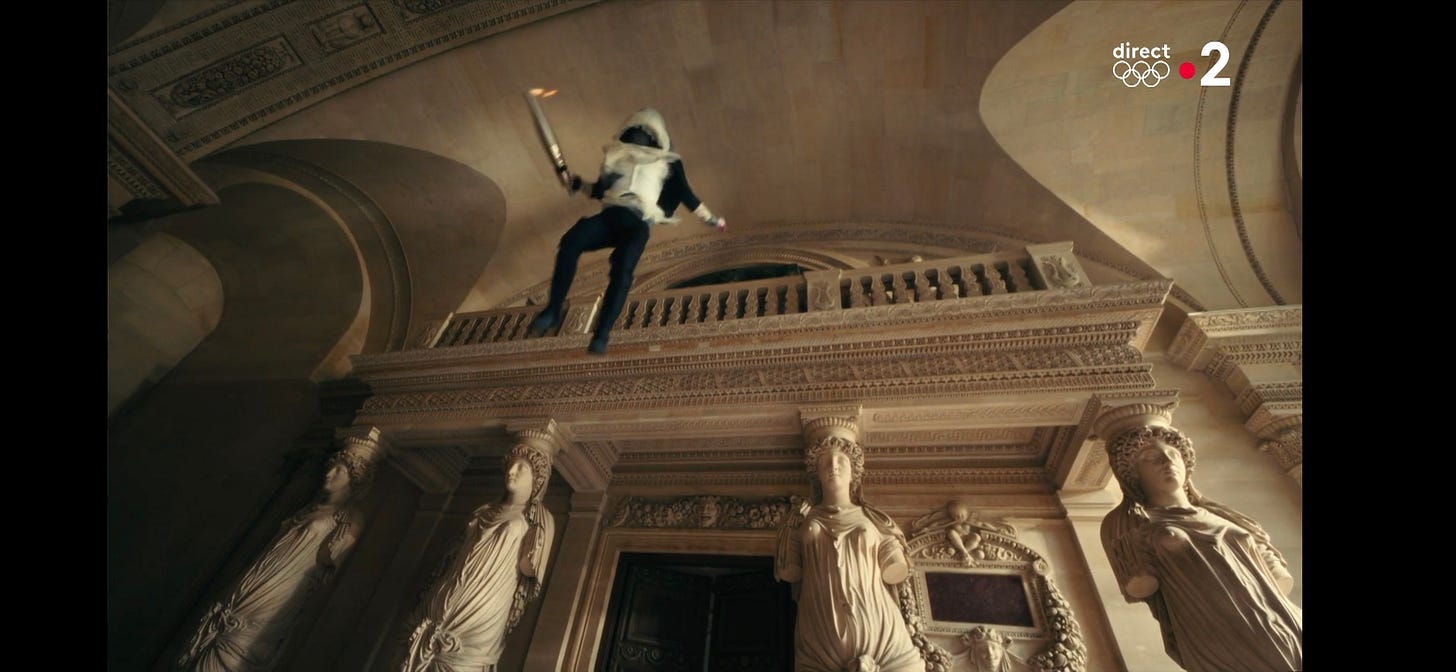
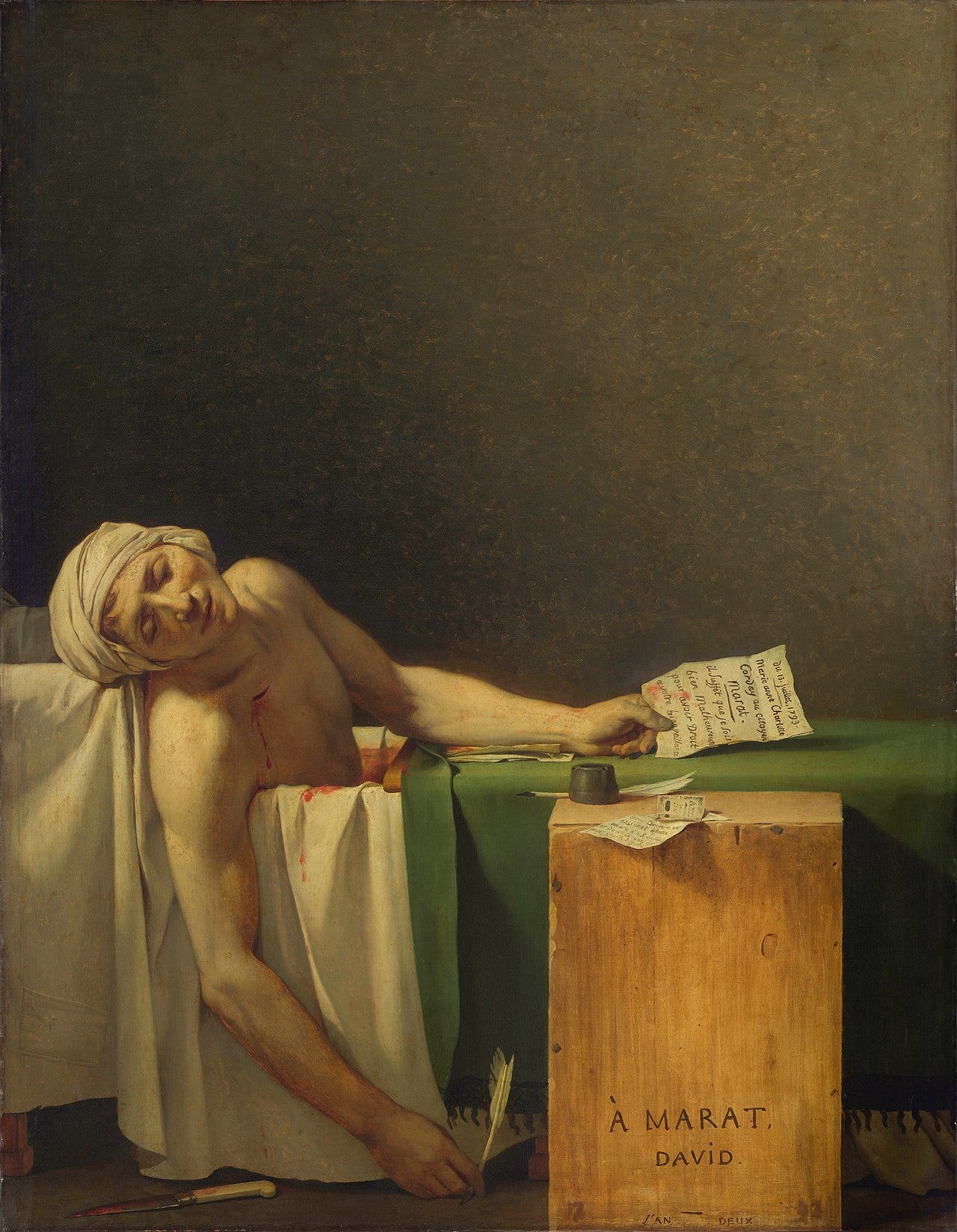
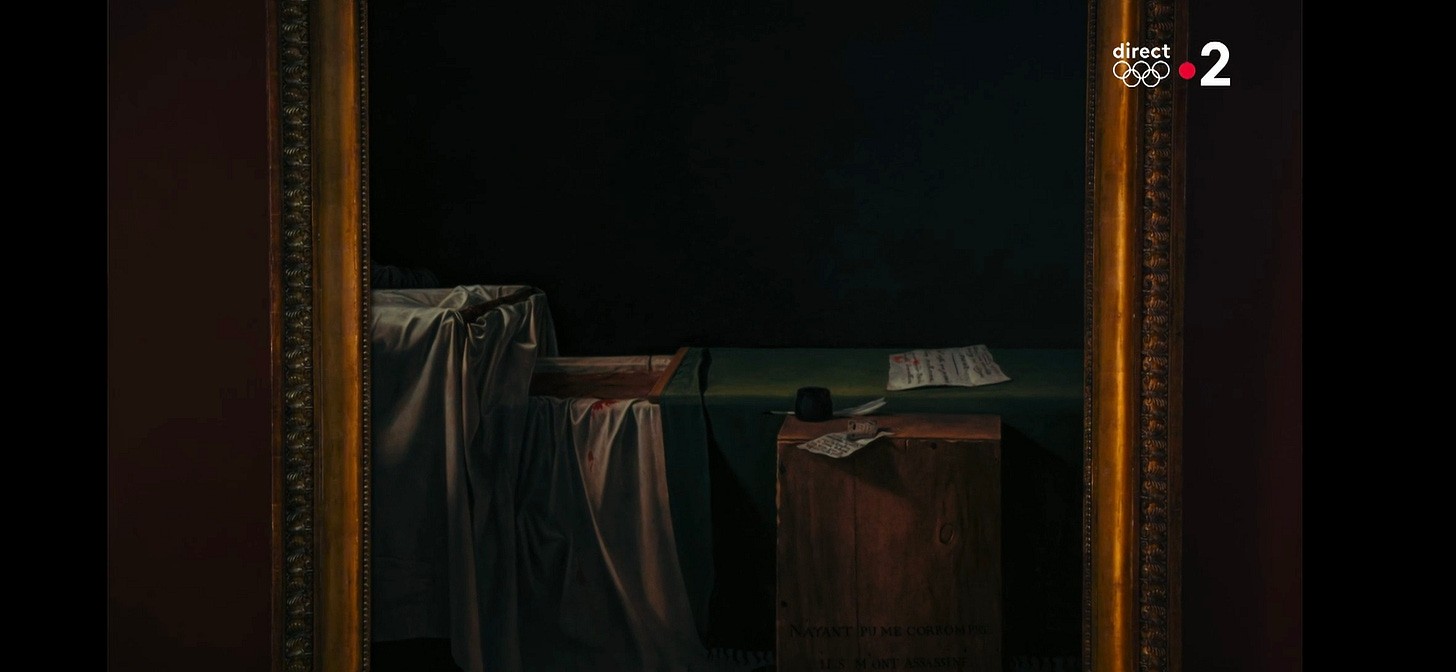


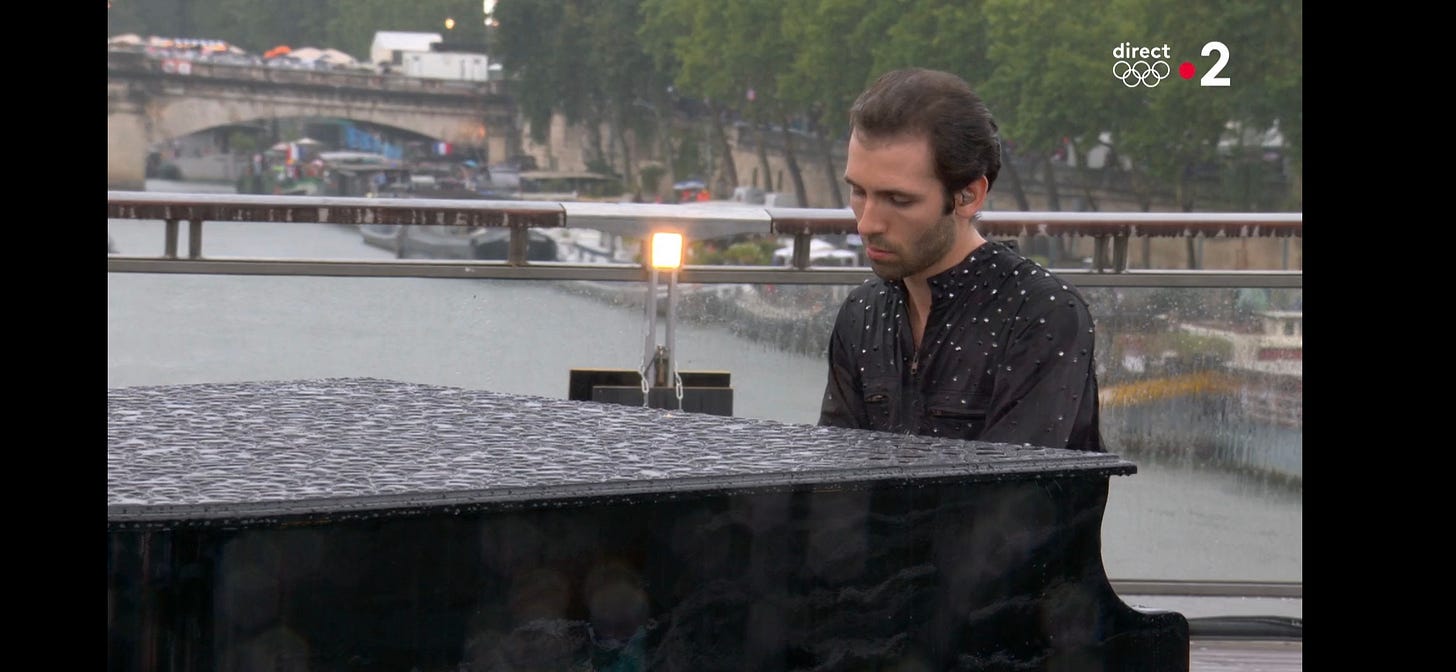






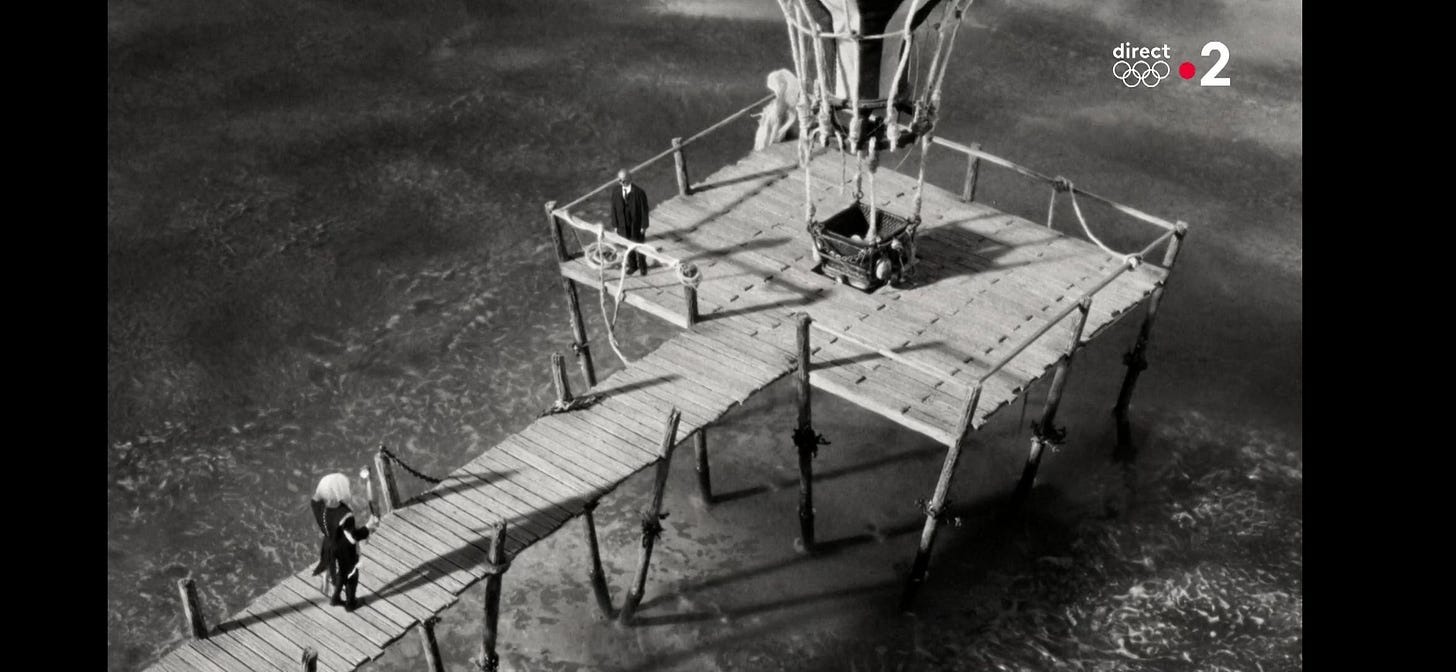
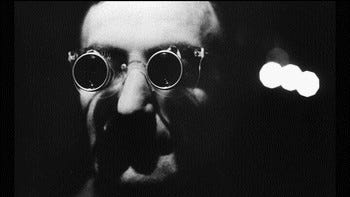
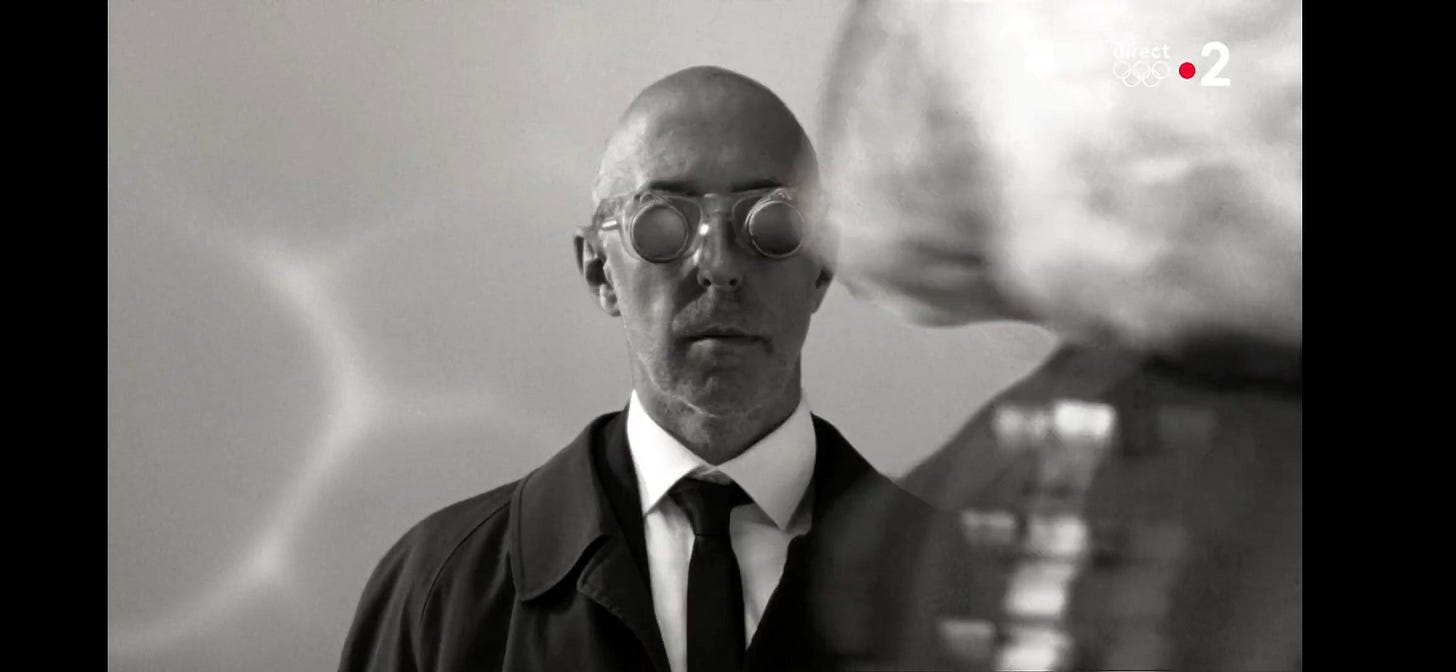

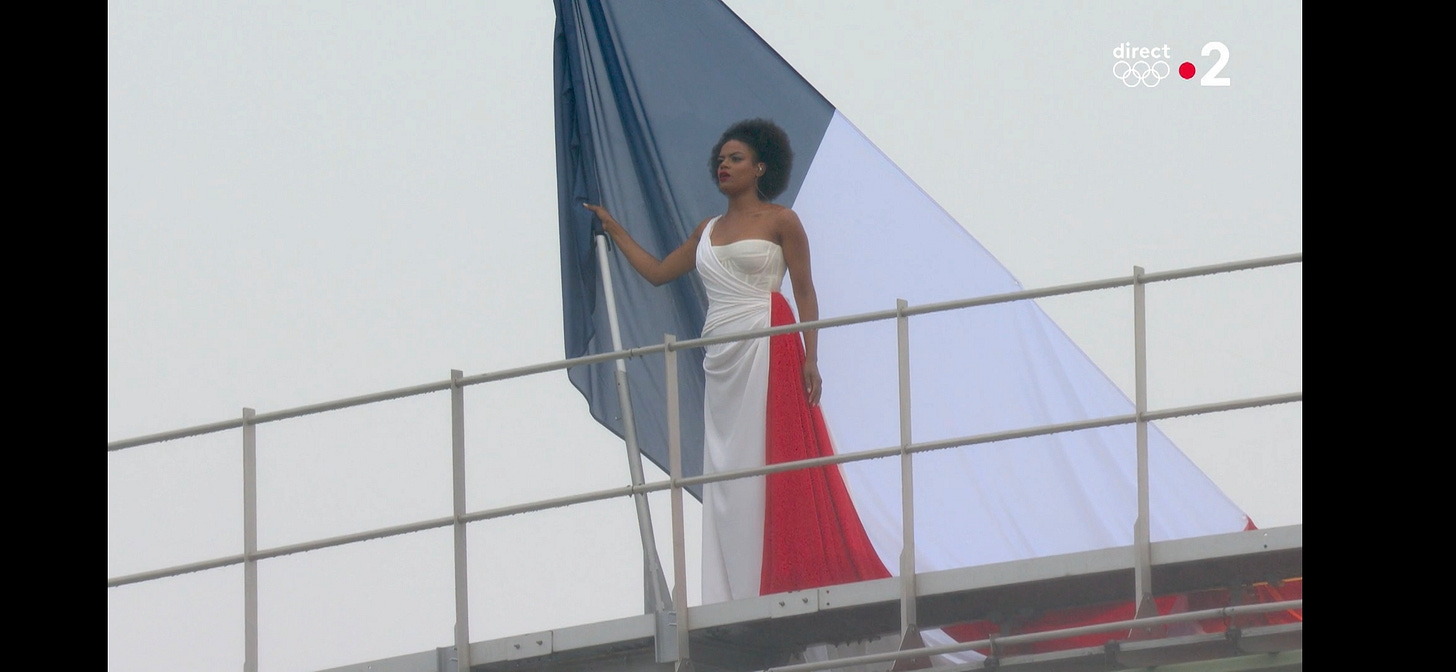


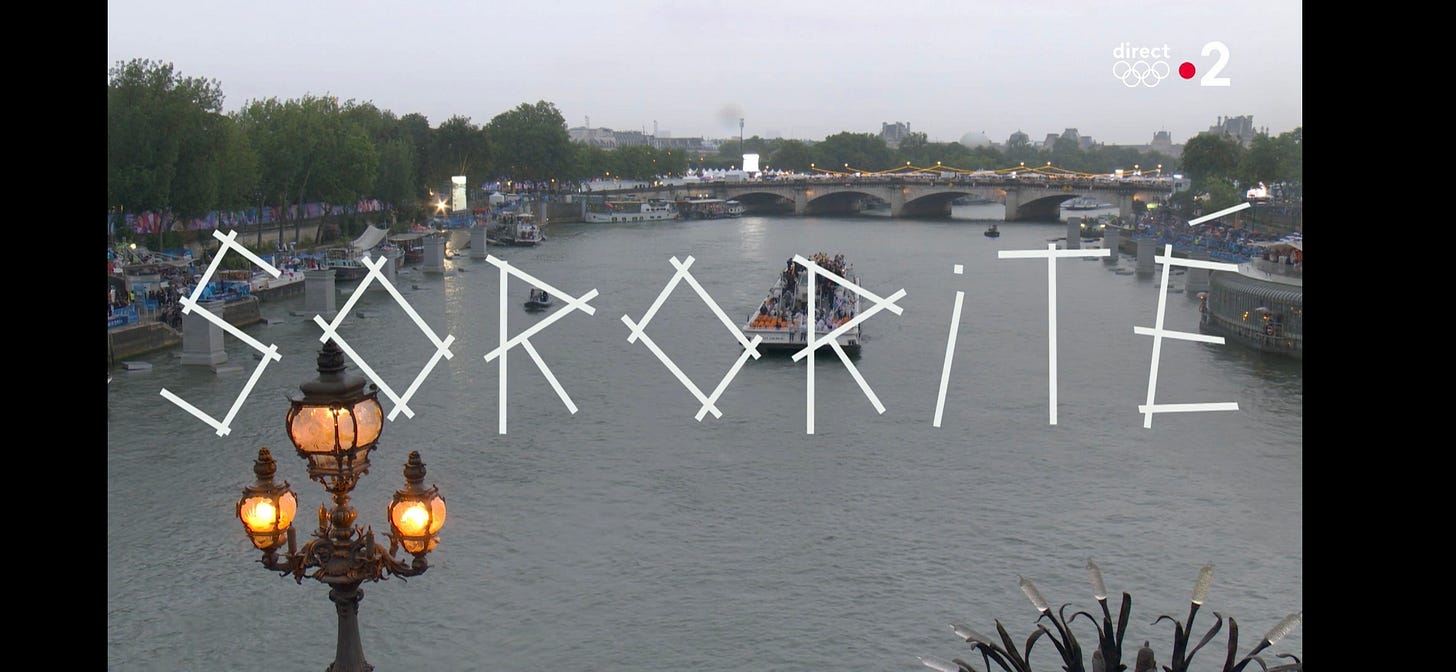
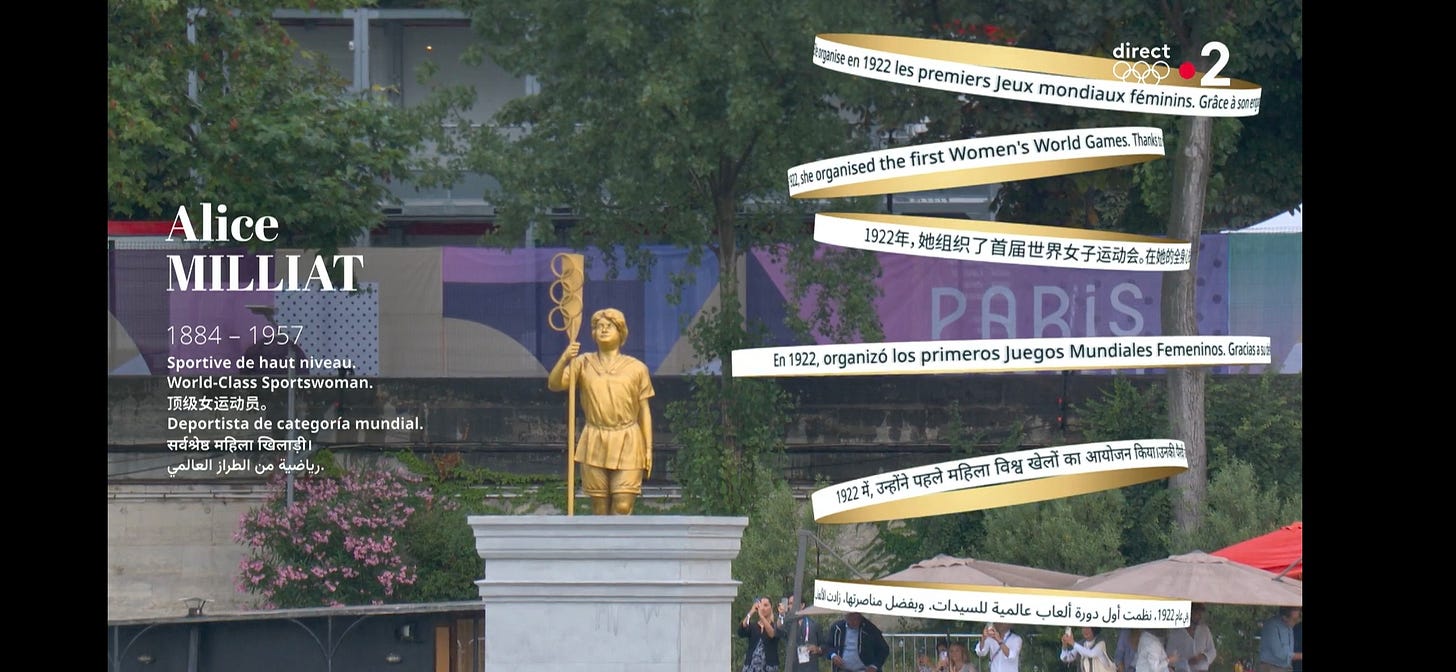

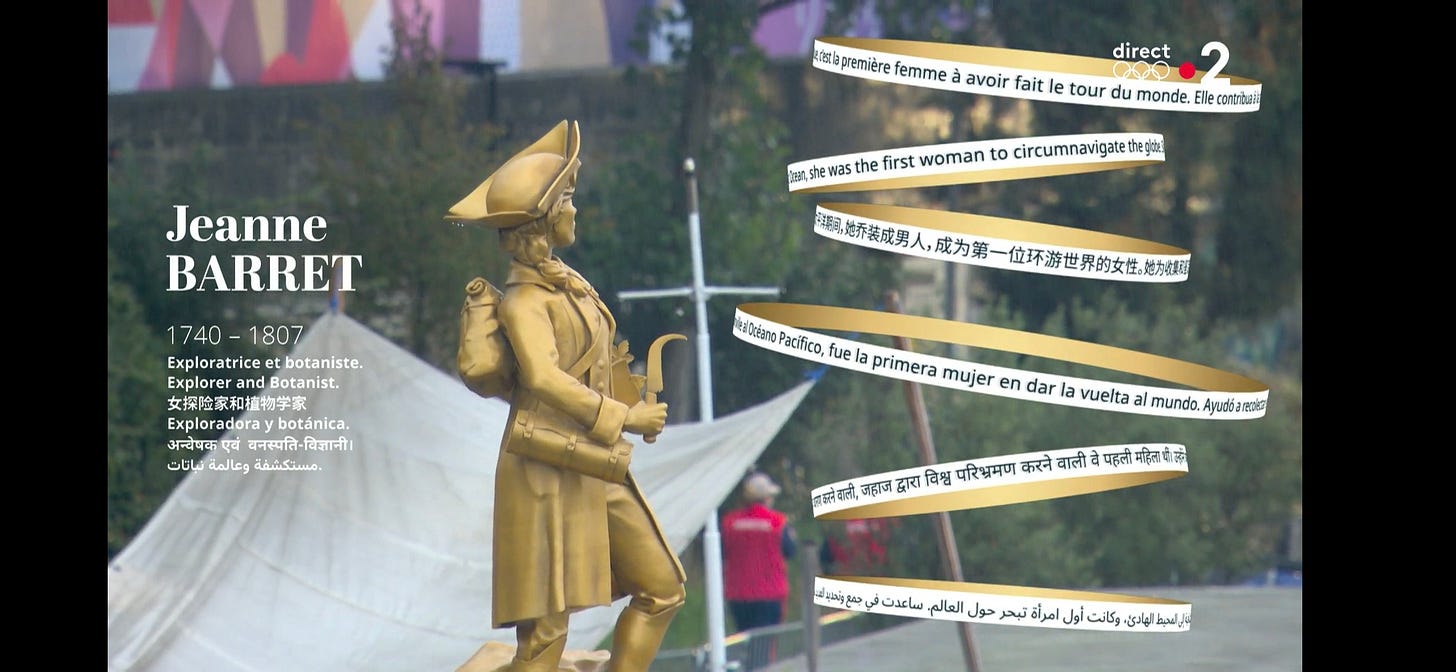





Another brilliant, thought-provoking, instructive read — thank you. I'm with you: I'm not a sports fan myself, but I love that sport brings joy to so many people.
Great read again! And I'm 1100% with you on "I don’t believe, but I care about believers". I wrote about this balancing act recently: I hate all religions but I always try very hard to respect people's faith (as long as they respect my lack of it, that is). Same goes for sport: I don't care about it but I'm happy for those who enjoy it... Looking forward to the next chapter of this series :)